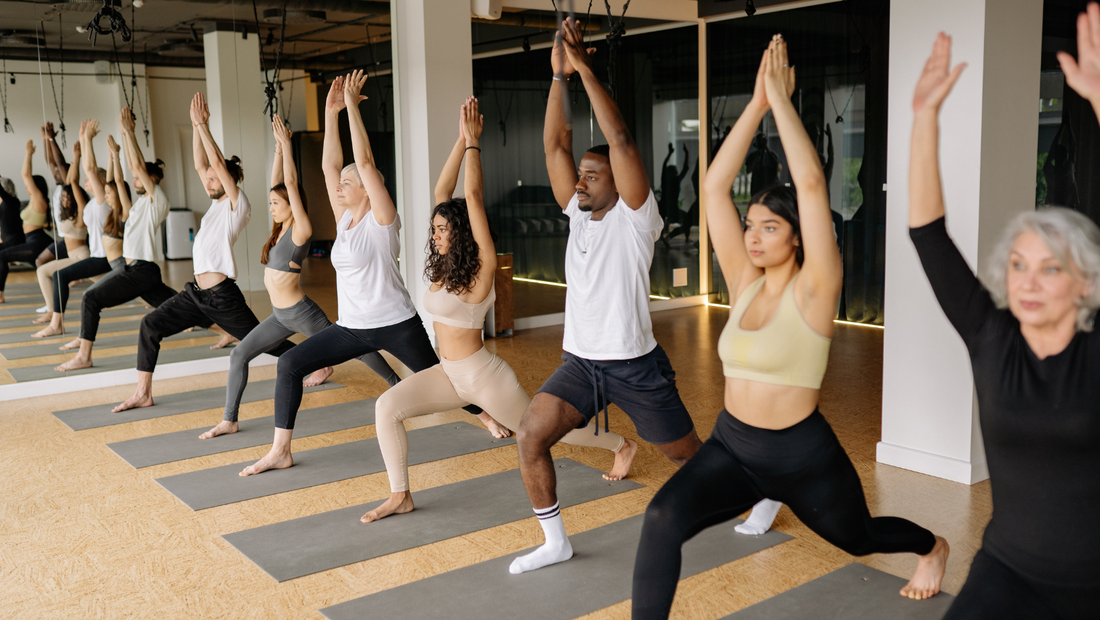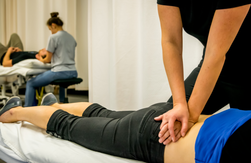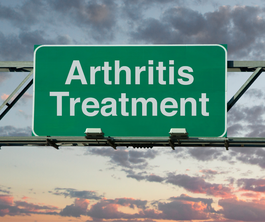 Don't fall off the treadmill (or bike, or rower, or...) New year's resolutions around fitness and exercise are incredibly popular. The excitement and hope generated by the start of the year makes starting an exercise program easy. Now that it's February, staying with it gets hard. Life gets busy, motivation drops, and suddenly you're back on the couch, wondering how you're 6 episodes into The Golden Bachelor instead of at the gym. You know the benefits of exercise - they're probably what motivated you to start exercising in the first place. If you need a reminder here are just a few: • 3 hours of exercise a week reduced pain and disability by 47% in people with knee arthritis. PTs are specially trained to help you learn to move with and avoid joint pain, we have doctorates! • Exercise reduced the progression of dementia by 50% • Exercise reduced the risk of hip fracture in post-menopausal women by 47% • A meta analysis showed exercise decreased anxiety by 48% • A low dose of exercise relieves depression in 30% of people, a higher dose works for 47% of people • A 12 year study of 10,000 Harvard alumni showed that people who exercised were 23% less likely to die • Exercise is the #1 treatment for fatigue Knowing that you should exercise or why you should exercise isn't the problem. Actually getting up and doing it is. Physical Therapists can help motivate you to move when you don't feel like it because you feel too weak or unsteady. Here are our top tips for making sure you stick to your exercise plan: Set realistic goals. Don't try to go from zero to hero overnight. Start with small, achievable goals and increase them gradually. Make it easy to win - that helps you build motivation and an exercise habit. For some people that might mean starting with a daily 10 minute walk. For some people, that bar is too high. When we say make it easy to win, we mean easy. Your goal could be to scan your card at the gym 3 times a week. It might be putting on your walking shoes and going out the door. It might be one pushup. Start tiny. Do activities you enjoy. Exercise ins't punishment. Choose activities that are fun. It could be running, walking the dog, dancing, swimming, kickboxing, or playing a sport. Schedule it. Schedule your workouts like you would any other important appointment. When people ask you to do something else during that time, say "sorry, I've got an appointment." The more you make exercise a routine, the less likely you are to skip it. Don't go it alone. Having someone waiting for you at the gym really motivates you to get there. Having support helps push you to work harder, and motivates you when you're feeling down. Your support could be a friend, the other people in a group fitness class, or a trainer. Physical Therapists are movement experts and can help guide you along the way, espeically if you have a previous injury that you are learning to work with. Mix it up. Try a new class. If you usually run at the same pace, try intervals. Walk a different route. Doing the same thing over and over again gets boring and leads to burnout. Keep things interesting to stay interested. Track your progress. Bonus points if you find a way to make it visual somehow. Our brains love to see tasks checked off, a chart or numbers going up, and rings closing. Seeing how far you've come is a great motivator. Keep track of your workouts in a journal, make a spreadsheet, use an app or fitness tracker. Bribes work. Celebrate your successes, no matter how small. Set a goal to work out 3 times this week and treat yourself to your favorite coffee when you do. Buy yourself a new workout outfit, get a massage, or anything else that will help you stay motivated when you reach milestones. Adjust. Don't push yourself too hard, especially when you're starting out. If you're feeling tired and sore, take the intensity down. Plan rest days into your routine. Don't make your goal and plan so rigid that it's impossible to complete in the real world. Forgive yourself! Everyone has setbacks. You're going to get sick. You're going to miss a workout. That's ok. Pick yourself up and get back on track. With the right mindset and a little perseverance, you can reach your fitness goals. References: 1. Updating ACSM’s Recommendations for Exercise Preparticipation Health Screening. Medicine & Science in Sports & Exercise 47(11):p 2473-2479, November 2015. https://journals.lww.com/acsmmsse/fulltext/2015/11000/updating_acsm_s_recommendations_for_exercise.28 .aspx 2. Benefits of exercise for older adults: a review of existing evidence and current recommendations for the general population. Clinics in geriatric medicine 8.1 (1992): 35-50. https://www.sciencedirect.com/science/article/abs/pii/S0749069018304968 3. Exercise Acts as a Drug https://bpspubs.onlinelibrary.wiley.com/doi/full/10.1111/j.14765381.2012.01970.x 4. Perceived Exercise Barriers https://doi.org/10.1002/art.22098 5. The Benefits of Exercise on Brain Health https://www.choosept.com/podcast/benefits-of-exercise-on-brain-health 6. Exercise Assessment and Prescription in the older adults and individuals at risk for functional decline https://learningcenter.apta.org/products/exerciseassessment-and-prescription-in-older-adults-and-individuals-at-risk-forfunctionaldecline?_gl=1*1c4v900*_ga*MTEwNjIzMzg2MS4xNjgxODQyODcw*_ga_ZZJK7 4HXNR*MTY5NzE5NzczNy4xMS4xLjE2OTcyMDAzODMuNTguMC4w&_ga=2.2 23614619.1495021570.1697197738-1106233861.1681842870 7. 23 and ½ hours: What is the single best thing we can do for our healtt. https://www.youtube.com/watch?v=aUaInS6HIGo 8. Time Magazine: How To Keep New Year's Resolutions: https://time.com/6243642/how-to-keep-new-years-resolutions-2/
0 Comments
 Active people of all types can benefit from the expertise of a physical therapist. Athletes, weekend warriors, and people who work in physically demanding jobs all need strength, mobility, coordination, and endurance. Physical therapists are experts in human movement that help active people stay that way. Physical therapists can help with performance. They can break down the requirements of a specific physical task and then design a training program that will help people meet those demands. A program designed by a physical therapist will improve strength, flexibility, coordination, agility and speed. It will focus on improving areas where a person is weak while also further improving areas of strength. While looking at an athlete or active person’s strength, mobility, balance, and coordination to improve performance, they’ll also be looking to identify issues that could lead to injury. The plan created by a PT will include exercises or activities to specifically address these areas. A PT can also assess an existing training plan and help to identify areas that may that may lead to sprains, strains, or overtraining. No matter how much training and injury prevention someone does, injuries sometimes happen. Physical therapists have the knowledge and skills to help people recover from injuries faster. In cases of severe injuries, physical therapists help people recover from surgery. But in some cases, a physical therapist can help people with injuries avoid surgery in the first place. Physical Therapy is more than just a way to get back on your feet after an injury - it also helps people stay at the top of their game. Whether it’s an athlete, a dancer, or someone who wants to stay in shape, physical therapy can help reach performance goals. With the right exercises and treatments, physical therapists help people improve strength, flexibility, and endurance so they perform at their best while lowering injury risk. If you've been to physical therapy, you likely got a home exercise program. Research says that if you do your home exercise program, you'll have a significantly better chance of meeting your goals and feeling better. Not doing your program increases the risk of recurrent injury or flareups with less positive outcomes long term. Even though they're important, adherence to home exercise programs is terrible. It's estimated that only 40 to 50% of patients do their exercises the way they're supposed to.
What can you do to make sure you do your exercises and get the best outcomes? Here are a few ideas. Plan ahead Think about what's going to get in your way your schedule, that you'll forget, or that you don't have the space or equipment that you need. Once you figure out the problems, come up with solutions. Put your exercises in your schedule, talk to your PT about equipment, or adjusting your program to fit the time you have. If you solve problems before they start, they're no longer problems. Address pain and beliefs You'll need to work with your PT on these. If your exercises cause pain, you're not going to do them. When your PT prescribes your exercises, try them out. If there's pain, ask your PT about modifications to make them more comfortable. The other thing might need addressed are your beliefs. If you believe that the exercises won't help, or that they're a waste of time, you won't do them. Again, work with your PT to understand why they're prescribing those exercises, and what they're meant to do. Once you know why you're doing those exercises, you're more likely to do them. Get support People who have social support are more likely to do their exercises. This is why CrossFit and group exercise classes work. Find a family member or friend to help you stay consistent with your exercises. Your PT can help here too. Have someone ask if you're doing your exercises, and how they're going. This will keep you accountable and more likely to do them. Use Technology If you like technology and gadgets, they can help you be consistent with your exercises. There are plenty of apps that can track your exercise. Seeing that streak of days you've exercised will motivate you not to break it. Smartwatches and activity trackers can fill the same role. Doing your home exercise program will help you get the most out of PT. With a little planning and a little help, you can make sure you're one of the 50% of the people who do their home exercises consistently to get the best outcomes. References: https://pubmed.ncbi.nlm.nih.gov/32669487/ https://www.physiopedia.com/Adherence_to_Home_Exercise_Programs  Arthritis is a chronic condition that causes inflammation of the joints. It can cause pain, stiffness, and swelling. The hips, knees, hands, and spine are the most commonly affected joints. Arthritis is not a single disease but an umbrella term that includes a variety of different types. Some of the more common examples are osteoarthritis, rheumatoid arthritis, gout, psoriatic arthritis and ankylosing spondylitis. While physical therapy might not be the first treatment you think of for arthritis, it probably should be. A lot of people with arthritis choose to use medication to manage their pain, stop activities that hurt, and wait for things to get bad enough to have a joint replacement. But this isn't a great plan, all medications have side effects, even over the counter ones. Reducing activity leads to muscle atrophy and even stiffer joints. Even though joint replacement surgery usually has good outcomes, it does come with its own set of risks and a painful recovery. Physical therapy has been extensively researched as a treatment for arthritis, and demonstrates good outcomes. Physical therapists typically start with exercise as the base for arthritis treatment. Exercise helps to regain lost joint motion, decrease feelings of stiffness, and strengthen muscles surrounding the affected joint. These benefits are all somewhat obvious. What surprises many people is that exercise has been shown to be as effective as medication for pain relief in many types of arthritis, without the side effects. Physical therapy has more to offer people with arthritis than just exercise though. Education helps people understand their condition, what to expect, and how to manage it. As experts in human movement, physical therapists are especially good at helping people modify the way they perform certain tasks or activities to reduce strain on joints affected by arthritis. They can also suggest ways to modify the environment at work or home to reduce pain and improve function. They may also suggest things like braces, orthotics, or other devices that can help maintain mobility and reduce pain. On top of all of that, PT has been proven to be a cost effective treatment, too. With so many techniques that are proven effective in helping people with arthritis, physical therapy is a recommended first line treatment for many types of arthritis. Now that you have a better understanding of what PT can do, hopefully you'll think of PT first when you think of arthritis too. References: 1. Research (peer-reviewed) a. PT for juvenile RA - https://pubmed.ncbi.nlm.nih.gov/1946625/ b. PT for hip and knee OA - https://pubmed.ncbi.nlm.nih.gov/33034560/ c. Systematic Review for Juvenile RA - https://pubmed.ncbi.nlm.nih.gov/28729171/ 2. Articles and Content a. Effectiveness and Cost-Effectiveness of Physical Therapy for Knee Osteoarthritis- https://www.rheumatology.org/About-Us/Newsroom/PressReleases/ID/718 b. Can physical therapy reduce arthritis pain? - https://www.medicalnewstoday.com/articles/physical-therapy-for-arthritis |
Archives
January 2024
Categories
All
|
- HOME
- About Us
-
Our Services
- Physical Therapy Evaluation
- Post Operative Care
- Neck & Back Pain, Joint Sprains & Strains
- PWR! Parkinson Wellness Recovery
- Vertigo, Balance Retraining & Vestibular Rehab
- TMJ, Headaches, Face Pain
- Lymphedema and CDT
- Sports Injuries
- General Conditioning - Post Covid Strengthening
- Functional Dry Needling
- Workers Comp & Work Conditioning
- Auto Accidents
- Augmented Soft Tissue Manipulation (ASTYM)
- Fall Prevention
- Testimonials
- Careers
- Contact Us
- MIMPT Blog
ADDRESS:52900 Garfield Rd
|
|

 RSS Feed
RSS Feed